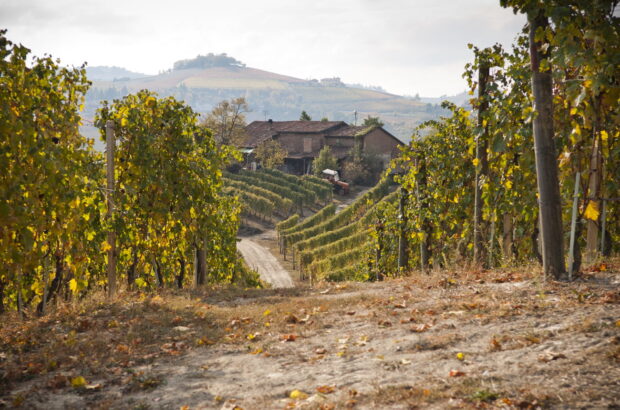Rioja Oriental used to be known as Rioja Baja. It used also to be known, anecdotally at least, as something of a poor relation; think of the comparison between the Aube and the Côtes des Blancs in Champagne, or between the Mâconnais and the Côte d’Or in Burgundy. This reputation, it transpires, was born as much as anything from ignorance, political expediency and a physical distance from the seat of power which, historically, has centred on the northwestern sector of the Rioja DOCa, closer to the early French influences and location of the largest and most powerful houses.
{"content":"PHA+VGhpbmdzIGFyZSBjaGFuZ2luZywgaG93ZXZlciwgYW5kIG5vdyBSaW9qYSBPcmllbnRhbCBpcyBiZWluZyBpbmNyZWFzaW5nbHkgbGF1ZGVkIGZvciB0aGUgdmVyeSB0aGluZ3Mgd2hpY2ggd2VyZSBvbmNlIHBlcmNlaXZlZCBhcyBpdHMgZHJhd2JhY2tzLiBIaXN0b3J5IGFuZCBnZW9ncmFwaHkgd2lsbCB0ZWFzZSBvdXQgdGhlIHJlYXNvbnMgd2h5LlJpb2phIGlzIGEgbG9uZywgY2lnYXItc2hhcGVkIHJlZ2lvbiwgaXRzIHRocmVlIGFkbWluaXN0cmF0aXZlIGh1YnMgcnVubmluZyBpbiBhIHNvdXRoLXNvdXRoZWFzdCBheGlzIGZvciBtb3JlIHRoYW4gMTAwa20gYW5kIGNvdmVyaW5nIG5lYXJseSA2NCwwMDBoYS4gT25lIG9mIHRoZXNlIGh1YnMsIExhIFJpb2phLCBjbGFpbXMgYWxsIHRoZSBsYW5kIHNvdXRoIG9mIHRoZSBFYnJvIHJpdmVyIGFuZCBpcyB0aGVyZWZvcmUgcmVwcmVzZW50ZWQgYnkgYm90aCBSaW9qYSBBbHRhIGFuZCBtdWNoIG9mIFJpb2phIE9yaWVudGFsLiBOb3J0aCBvZiB0aGUgcml2ZXIgd2UgaGF2ZSB0aGUgQmFzcXVlIHByb3ZpbmNlIG9mIEFsYXZhIChSaW9qYSBBbGF2ZXNhKSBhbmQsIGZ1cnRoZXIgdG8gdGhlIGVhc3QsIE5hdmFycmEuIFJpb2phIE9yaWVudGFsIHN0cmFkZGxlcyB0aGUgcml2ZXIgaW4gdGhlIGVhc3Rlcm4gc2VjdG9yLCBhbmQgdGhlcmVmb3JlIGlzIGRpdmlkZWQgYWNyb3NzIGJvdGggYXV0b25vbW91cyBkaXN0cmljdHMgb2YgTGEgUmlvamEgYW5kIE5hdmFycmEg4oCTIGluIGVzc2VuY2UsIGFsbCBwb2ludHMgZWFzdCBhbmQgc291dGhlYXN0IG9mIHRoZSByZWdpb25hbCBjYXBpdGFsIG9mIExvZ3Jvw7FvLCBoZW5jZSB0aGUgbmFtZSDigJhPcmllbnRhbOKAmSwgd2hpY2ggbWVhbnMg4oCYRWFzdGVybuKAmSBpbiBTcGFuaXNoLjwvcD4KPHA+PGRpdiBjbGFzcz0iYWQtY29udGFpbmVyIGFkLWNvbnRhaW5lci0tbW9iaWxlIj48ZGl2IGlkPSJwb3N0LWlubGluZS0xIiBjbGFzcz0iaXBjLWFkdmVydCI+PC9kaXY+PC9kaXY+PC9wPgo8cD5IaXN0b3JpY2FsbHksIGZvY3VzIGhhcyBiZWVuIG9uIExvZ3Jvw7FvLCBmb3Igc3VyZSwgYnV0IG1vcmUgc3BlY2lmaWNhbGx5IG9uIHRoZSB0b3duIG9mIEhhcm8gZGVlcCBpbnRvIExhIFJpb2phIEFsdGEuIFRoZSBmYW1vdXMgTWFycXVlc2VzIG9mIFJpc2NhbCBhbmQgTXVycmlldGEgd2FudGVkIHRvIGNyZWF0ZSBjb25kaXRpb25zIGFzIGNsb3NlIHRvIEZyYW5jZSBhcyBwb3NzaWJsZTsgaGVyZSB0aGUgQXRsYW50aWMgaW5mbHVlbmNlIHdhcyBzZWVuIGFzIHRoZSBtb3N0IGJlbmV2b2xlbnQsIGFuZCBoZXJlIGFuZCBvbmx5IGhlcmUgY291bGQgdGhlIEJvcmRlbGFpcyBtb2RlbCBiZSByZWZhc2hpb25lZC4gTGVhdmUgdGhlIHJ1c3RpYyBHYXJuYWNoYSB0byB0aGUgc21hbGwgZmFybWVycyBvdXQgZWFzdCYjODIzMDsgT2gsIGJ1dCBtYWtlIHN1cmUgdGhleSBzZWxsIHVzIHNvbWUgb2YgdGhlaXIgZ3JhcGVzLCBwcmVmZXJhYmx5IHBheWluZyBhIGxlc3MgdGhhbiBnZW5lcm91cyBwcmljZS48L3A+CjxwPlRodXMgd2FzIGJvcm4gYSBjb21tZXJjaWFsIGhlZ2Vtb255IGFuZCBhIGJ1c2luZXNzIG1vZGVsIHdoaWNoLCBtb3JlIHRoYW4gYW55d2hlcmUgZWxzZSBpbiBTcGFpbiwgaGFzIGJlZW4gYnVpbHQgb24gYnJhbmRpbmcgYW5kIGZhbW91cyBuYW1lcy4gQSBnZW5lcmFsbHkgc3VjY2Vzc2Z1bCBtb2RlbCwgaXQgaGFzIHRvIGJlIHNhaWQsIGJ1dCBub3Qgb25lIHRoYXQgcmVhbGx5IGdpdmVzIGZ1bGwgdm9pY2UgdG8gdGhlIHJpY2ggZGl2ZXJzaXR5IG9mIHRoaXMgZmFzY2luYXRpbmcgcmVnaW9uLiBFdmVuIG5vdywgZGVzcGl0ZSBjb3ZlcmluZyAzOCUgb2YgdGhlIGxhbmQsIFJpb2phIE9yaWVudGFsIGlzIHJlc3BvbnNpYmxlIGZvciB0aGUgYWN0dWFsIHByb2R1Y3Rpb24gb2Ygb25seSBhYm91dCAyNiUgb2YgdGhlIHdpbmU7IGdyYXBlcyBhcmUgc3RpbGwgdHJhbnNwb3J0ZWQgaW4gYnVsayB0byB0aGUgbGFyZ2UgYm9kZWdhcyB1cHN0cmVhbS48L3A+CjxkaXYgY2xhc3M9ImJyZWFrb3V0IHBhbGV0dGUtYSBwYW5lbCBwYW5lbC1kZWZhdWx0Ij48ZGl2IGNsYXNzPSJwYW5lbC1ib2R5Ij48ZGl2IGNsYXNzPSdicmVha291dC1jb250ZW50Jz48L3A+CjxkaXYgY2xhc3M9ImFkLWNvbnRhaW5lciBhZC1jb250YWluZXItLW1vYmlsZSI+CjxkaXYgaWQ9InBvc3QtaW5saW5lLTIiIGNsYXNzPSJpcGMtYWR2ZXJ0Ij48L2Rpdj4KPC9kaXY+CjxoMyBzdHlsZT0idGV4dC1hbGlnbjogbGVmdCI+PHN0cm9uZz5SaW9qYSBPcmllbnRhbCBhdCBhIGdsYW5jZTwvc3Ryb25nPjwvaDM+CjxwIHN0eWxlPSJ0ZXh0LWFsaWduOiBsZWZ0Ij48c3Ryb25nPk5hbWU8L3N0cm9uZz4gQ2hhbmdlZCBmcm9tIFJpb2phIEJhamEgdG8gUmlvamEgT3JpZW50YWwgaW4gMjAxODwvcD4KPHAgc3R5bGU9InRleHQtYWxpZ246IGxlZnQiPjxzdHJvbmc+VmluZXlhcmRzPC9zdHJvbmc+IDM4JSBvZiBSaW9qYSB0b3RhbCBieSBhcmVhPC9wPgo8cCBzdHlsZT0idGV4dC1hbGlnbjogbGVmdCI+PHN0cm9uZz5QbGFudGVkIGFyZWE8L3N0cm9uZz4gMjIsOTQwaGEgcmVkIGdyYXBlczsgMiwwMzRoYSB3aGl0ZSBncmFwZXM8L3A+CjxkaXYgY2xhc3M9ImFkLWNvbnRhaW5lciBhZC1jb250YWluZXItLW1vYmlsZSI+CjxkaXYgaWQ9InBvc3QtaW5saW5lLTMiIGNsYXNzPSJpcGMtYWR2ZXJ0Ij48L2Rpdj4KPC9kaXY+CjxwIHN0eWxlPSJ0ZXh0LWFsaWduOiBsZWZ0Ij48c3Ryb25nPkFubnVhbCBwcm9kdWN0aW9uPC9zdHJvbmc+IDg3bSBsaXRyZXMsIDI2JSBvZiB0aGUgUmlvamEgdG90YWwgaW4gMjAxOCAoMzM2bSBsaXRyZXMpPC9wPgo8cCBzdHlsZT0idGV4dC1hbGlnbjogbGVmdCI+PHN0cm9uZz5HcmFwZXM8L3N0cm9uZz4gVGVtcHJhbmlsbG8gNzIlLCBHYXJuYWNoYSAxMyUsIEdyYWNpYW5vIDQlLCBNYXp1ZWxvIDMlLCBWaXVyYSAzJSwgVGVtcHJhbmlsbG8gQmxhbmNvIDIlLCBWZXJkZWpvIDElLCBvdGhlcnMgMiU8L3A+CjwvZGl2PjxkaXYgY2xhc3M9J2JyZWFrb3V0LWJ1dHRvbnMnPjxkaXYgY2xhc3M9J3Jvdyc+PC9kaXY+PC9kaXY+PC9kaXY+PC9kaXY+CjxkaXYgY2xhc3M9ImFkLWNvbnRhaW5lciBhZC1jb250YWluZXItLW1vYmlsZSI+PGRpdiBpZD0icG9zdC1pbmxpbmUtNCIgY2xhc3M9ImlwYy1hZHZlcnQiPjwvZGl2PjwvZGl2Pgo8aDMgc3R5bGU9InRleHQtYWxpZ246IGxlZnQiPjxzdHJvbmc+PGJyIC8+CldoYXTigJlzIGluIGEgbmFtZT88L3N0cm9uZz48L2gzPgo8cD5TbG93bHkgYnV0IHN1cmVseSB0aG91Z2gsIHRoaW5ncyBhcmUgY2hhbmdpbmcsIGFuZCB3aGVyZSBiZXR0ZXIgdG8gc3RhcnQgdGhhbiB0aGUgbmFtZT8gVGhlIHRlcm0g4oCYQmFqYeKAmSB3YXMgcGVyY2VpdmVkIGFzIHByb2JsZW1hdGljIGZvciB0d28gcmVhc29uczogZmlyc3RseSBiZWNhdXNlIGl0IG1lYW5zIOKAmGxvd2Vy4oCZIGFuZCB0aGVyZWZvcmUgaGVsZCBhbiBhc3NvY2lhdGlvbiBvZiBpbmZlcmlvcml0eTsgc2Vjb25kbHkgYmVjYXVzZSwgdG9wb2dyYXBoaWNhbGx5LCB0aGUgc3ViLXJlZ2lvbiBpcyBub3Qg4oCYbG93ZXLigJkgYXQgYWxsLiBJbmRlZWQsIGEgY29tbW9ubHkgb3Zlcmxvb2tlZCBmYWN0IGlzIHRoYXQgT3JpZW50YWwgaXMgaG9tZSB0byBzb21lIG9mIHRoZSBoaWdoZXN0IHZpbmV5YXJkcyBpbiBSaW9qYSwgbW9zdCBmYW1vdXNseSB0aGUgU2llcnJhIGRlIFllcmdhIHdheSBvdXQgdG8gdGhlIGVhc3QuPC9wPgo8cD5UaGUgbmFtZSBjaGFuZ2UgaGFzIGRpdmlkZWQgb3BpbmlvbnMsIG9mIGNvdXJzZS4gUm9kb2xmbyBCYXN0aWRhIGZyb20gUmFtw7NuIEJpbGJhbyBpcyBwb3NpdGl2ZSBhbmQgZGVzY3JpYmVzIGl0IGFzIOKAmGFuIG9wdGltaXN0aWMgc3RhdGVtZW50IG9mIGEgcmViaXJ0aOKAmS4gTWVhbndoaWxlLCBnYXJhZ2lzdGUgd2luZW1ha2VyIEphdmllciBBcml6Y3VyZW4gaXMgbW9yZSBmb3J0aHJpZ2h0OiDigJhBIGxvdCBtb3JlIHdvcmsgaGFzIHRvIGJlIGRvbmUgdG8gZGVmZW5kIGFuZCBleHBsYWluIG91ciByaWNoIGhlcml0YWdlLOKAmSBoZSBzYXlzLCBiZWZvcmUg4oCYY29uZnVzaW5nIHRoZSB3b3JsZCBhdCBsYXJnZeKAmSB3aXRoIHR3ZWFrcyB0byBub21lbmNsYXR1cmUuPC9wPgo8ZGl2IGNsYXNzPSJhZC1jb250YWluZXIgYWQtY29udGFpbmVyLS1tb2JpbGUiPjxkaXYgaWQ9InBvc3QtaW5saW5lLTUiIGNsYXNzPSJpcGMtYWR2ZXJ0Ij48L2Rpdj48L2Rpdj4KPHA+UmFxdWVsIFDDqXJleiBDdWV2YXMgZnJvbSBCb2RlZ2FzIE9udGHDscOzbiwgaXMgbW9yZSBwaGlsb3NvcGhpY2FsLiDigJhPcmllbnTigJkgbWVhbnMgYmlydGggaW4gTGF0aW4sIHNoZSBub3RlcywgYW5kIHRoaXMgbmFtZSBjaGFuZ2UgaXMgYWxsIGFib3V0IHJlYmlydGg7IGl0IGFsc28gbWVhbnMgZWFzdC1mYWNpbmcsIHdoaWNoIG1ha2VzIGl0IGFsbCB0aGUgbW9yZSBzdWl0YWJsZS4g4oCYVGhlcmUgaXMgc3VjaCBhIHJpY2ggaGlzdG9yeSBpbiBvdXIgcmVnaW9uLOKAmSBzaGUgYWRkcywgcmVjYWxsaW5nIHRoZSBDaXN0ZXJjaWFuIG1vbmtzIHdobyBjdWx0aXZhdGVkIHZpbmVzIGluIGhlciB2aWxsYWdlIG9mIFF1ZWwgbG9uZyBiZWZvcmUgdGhlIGFkdmVudHVyZXMgb2YgU2XDsW9ycyBSaXNjYWwsIFZhcmdhcyBldCBhbC4g4oCYVGhleSBhbHNvIGJ1aWx0IGNodXJjaGVzIGZhY2luZyBlYXN0IeKAmSBJdCBzZWVtcyB0aGF0IGZvciB0aGUgeW91bmdlciBnZW5lcmF0aW9uIHRoZXJl4oCZcyBhbiBhbG1vc3QgbXlzdGljYWwgYXBwcm9wcmlhdGlvbiB0byB0aGUgbmV3IG5hbWluZyBwcm9qZWN0LjwvcD4KPGRpdiBpZD0iYXR0YWNobWVudF80MzE1MTQiIHN0eWxlPSJ3aWR0aDogMTMxMHB4IiBjbGFzcz0id3AtY2FwdGlvbiBhbGlnbm5vbmUiPjxpbWcgZmV0Y2hwcmlvcml0eT0iaGlnaCIgZGVjb2Rpbmc9ImFzeW5jIiBhcmlhLWRlc2NyaWJlZGJ5PSJjYXB0aW9uLWF0dGFjaG1lbnQtNDMxNTE0IiBjbGFzcz0ibGF6eWxvYWQgYmx1ci11cCBzaXplLWZ1bGwgd3AtaW1hZ2UtNDMxNTE0IiBkYXRhLXByb2Nlc3NlZCBzcmM9Imh0dHBzOi8vd3d3LmRlY2FudGVyLmNvbS93cC1jb250ZW50L3RoZW1lcy9zaW1iYS10aGVtZS9hc3NldHMvaW1hZ2VzL3BsYWNlaG9sZGVyLnBuZyIgZGF0YS1zcmM9Imh0dHBzOi8va2V5YXNzZXRzLnRpbWVpbmN1ay5uZXQvaW5zcGlyZXdwL2xpdmUvd3AtY29udGVudC91cGxvYWRzL3NpdGVzLzM0LzIwMjAvMDIvQm9kZWdhcy1CdXJnby1WaWVqby5qcGciIGFsdD0iQm9kZWdhcyBCdXJnbyBWaWVqbyIgd2lkdGg9IjEzMDAiIGhlaWdodD0iODYwIiBkYXRhLXNpemVzPSJhdXRvIiBkYXRhLXNyY3NldD0iaHR0cHM6Ly9rZXlhc3NldHMudGltZWluY3VrLm5ldC9pbnNwaXJld3AvbGl2ZS93cC1jb250ZW50L3VwbG9hZHMvc2l0ZXMvMzQvMjAyMC8wMi9Cb2RlZ2FzLUJ1cmdvLVZpZWpvLmpwZyAxMzAwdywgaHR0cHM6Ly9rZXlhc3NldHMudGltZWluY3VrLm5ldC9pbnNwaXJld3AvbGl2ZS93cC1jb250ZW50L3VwbG9hZHMvc2l0ZXMvMzQvMjAyMC8wMi9Cb2RlZ2FzLUJ1cmdvLVZpZWpvLTMwMHgxOTguanBnIDMwMHcsIGh0dHBzOi8va2V5YXNzZXRzLnRpbWVpbmN1ay5uZXQvaW5zcGlyZXdwL2xpdmUvd3AtY29udGVudC91cGxvYWRzL3NpdGVzLzM0LzIwMjAvMDIvQm9kZWdhcy1CdXJnby1WaWVqby02MzB4NDE3LmpwZyA2MzB3LCBodHRwczovL2tleWFzc2V0cy50aW1laW5jdWsubmV0L2luc3BpcmV3cC9saXZlL3dwLWNvbnRlbnQvdXBsb2Fkcy9zaXRlcy8zNC8yMDIwLzAyL0JvZGVnYXMtQnVyZ28tVmllam8tMTM1eDg5LmpwZyAxMzV3LCBodHRwczovL2tleWFzc2V0cy50aW1laW5jdWsubmV0L2luc3BpcmV3cC9saXZlL3dwLWNvbnRlbnQvdXBsb2Fkcy9zaXRlcy8zNC8yMDIwLzAyL0JvZGVnYXMtQnVyZ28tVmllam8tMzIweDIxMi5qcGcgMzIwdywgaHR0cHM6Ly9rZXlhc3NldHMudGltZWluY3VrLm5ldC9pbnNwaXJld3AvbGl2ZS93cC1jb250ZW50L3VwbG9hZHMvc2l0ZXMvMzQvMjAyMC8wMi9Cb2RlZ2FzLUJ1cmdvLVZpZWpvLTYyMHg0MTAuanBnIDYyMHcsIGh0dHBzOi8va2V5YXNzZXRzLnRpbWVpbmN1ay5uZXQvaW5zcGlyZXdwL2xpdmUvd3AtY29udGVudC91cGxvYWRzL3NpdGVzLzM0LzIwMjAvMDIvQm9kZWdhcy1CdXJnby1WaWVqby05MjB4NjA5LmpwZyA5MjB3LCBodHRwczovL2tleWFzc2V0cy50aW1laW5jdWsubmV0L2luc3BpcmV3cC9saXZlL3dwLWNvbnRlbnQvdXBsb2Fkcy9zaXRlcy8zNC8yMDIwLzAyL0JvZGVnYXMtQnVyZ28tVmllam8tMTIyMHg4MDcuanBnIDEyMjB3IiBzaXplcz0iKG1heC13aWR0aDogMTMwMHB4KSAxMDB2dywgMTMwMHB4IiAvPjxwIGlkPSJjYXB0aW9uLWF0dGFjaG1lbnQtNDMxNTE0IiBjbGFzcz0id3AtY2FwdGlvbi10ZXh0Ij5WaW5lcyBhdCBCb2RlZ2FzIEJ1cmdvIFZpZWpvPC9wPjwvZGl2Pgo8aDM+PHN0cm9uZz5Qcm91ZCBhbWJpdGlvbnM8L3N0cm9uZz48L2gzPgo8cD5UaGVpcnMgaXMgbm8gZWFzeSBlbmRlYXZvdXIsIGhvd2V2ZXIuIE9uZSBzdGF0aXN0aWMgbWFrZXMgaXQgY2xlYXIgaG93IG11Y2ggdGhlIHJlZ2lvbmFsIGlkZW50aXR5IGhhcyBiZWVuIHN1YnN1bWVkIGJ5IHdpZGVyIHByb2plY3RzIG9mIHNlbGYtaW50ZXJlc3QuIEluIDE5ODIsIEdhcm5hY2hhIGNvdmVyZWQgNzQlIG9mIHRoZSB2aW5leWFyZHMgb2Ygd2hhdCB3YXMgdGhlbiBSaW9qYSBCYWphOyBub3cgdGhlIGZpZ3VyZSBpcyBjbG9zZXIgdG8gMTMlLiBBcml6Y3VyZW4gc2hvd3MgbWUgYWVyaWFsIG1hcHMgZnJvbSB0aGUgdHdvIGVyYXMgYW5kIGl0IGFsc28gYmVjb21lcyBjbGVhciB0aGF0IHRoZSBoaWxsc2lkZSB2aW5leWFyZHMgaGF2ZSBsYXJnZWx5IGJlZW4gZm9yc2FrZW4gZm9yIFRlbXByYW5pbGxvIHBsYW50aW5ncyBpbiB0aGUgZmVydGlsZSBhbGx1dmlhbCBzb2lscyB3aGljaCBzdXJyb3VuZCB0aGUgRWJybywgd2hlcmUgaXQgaXMgY2VydGFpbmx5IHdhcm1lciwgYW5kIHRoZSBncmFwZXMgYXJlIGZhciBtb3JlIHByb2R1Y3RpdmUgYW5kIGFtZW5hYmxlLjwvcD4KPHA+VGhlcmUgaXMgYSBkaXZpc2lvbiBiZXR3ZWVuIHRoaXMgYXBwcm9hY2ggYW5kIHRoYXQgYWRvcHRlZCBieSBhbiBpbmNyZWFzaW5nbHkgdm9jYWwgYmFuZCBvZiBicm90aGVycyB3aG8gYXJlIHNlZWtpbmcgdG8gcmVzdG9yZSB3aGF0IHRoZXkgcGVyY2VpdmUgdG8gYmUgdGhlIHJpZ2h0ZnVsIGdyYXBlIHZhcmlldHkgdG8gaXRzIHJpZ2h0ZnVsIGhvbWVzdGVhZC4gT25lIG9mIHRoZWlyIGJlc3Qta25vd24gYW1iYXNzYWRvcnMgaXMgQWx2YXJvIFBhbGFjaW9zLCB3aG8sIG9uIHRoZSBiYWNrIG9mIHNpbWlsYXIgcmVzdG9yYXRpdmUgcHJvamVjdHMgaW4gUHJpb3JhdCBhbmQgQmllcnpvLCBpcyBub3cgbGVhZGluZyB0aGUgY2hhcmdlIHRvIHJldml0YWxpc2UgdGhlIHdpbmVzIGZyb20gaGlzIGZhbWlseSBib2RlZ2EsIGxvY2F0ZWQgaW4gQWxmYXJvLjwvcD4KPHA+VGhlIGluZmx1ZW50aWFsIEJhc3RpZGEgb2YgUmFtw7NuIEJpbGJhbyBpcyBlbnRpcmVseSBpbiBhZ3JlZW1lbnQuIOKAmFRoZSB0ZW1wZXJhdHVyZSBkZWNyZWFzZXMgYnkgMC4zwrBDIGZvciBldmVyeSAxMDBtIG9mIGFsdGl0dWRlLOKAmSBoZSBzYXlzLCBleHBsYWluaW5nIHRoYXQgdGhlIGNoYWxsZW5nZSBpcyB0byDigJhleHBsb2l0IHRoZSBncmVhdCBwb3RlbnRpYWwgZm9yIGZyZXNobmVzcywgZGl1cm5hbCB2YXJpYXRpb24sIGFuZCB0aHVzIGNyZWF0ZSBhbiBvcHBvcnR1bml0eSBmb3IgR2FybmFjaGEgdG8gZXhwcmVzcyBpdHMgZnVsbCBwb3RlbnRpYWzigJkuIEZhciBmcm9tIHRoZSBqYW1teSwgb3Zlci1hbGNvaG9saWMgc3R5bGVzIG9mIFJpb2phLCBzb21lIG1hZGUgYnkgY2FyYm9uaWMgbWFjZXJhdGlvbiwgaGUgaXMgbG9va2luZyB0byByZWNyZWF0ZSBzb21ldGhpbmcgYXBwcm9hY2hpbmcgQ2jDonRlYXVuZXVmLWR1LVBhcGUsIGV2ZW4gY2l0aW5nIGFuIGFwcHJvcHJpYXRlIGNvbWJpbmF0aW9uIG9mIHNhbmQgYW5kIHBlYmJsZXMgaW4gaGlzIHZpbmV5YXJkcyBhdCBUdWRlbGlsbGEuIENow6J0ZWF1bmV1ZiB3aXRoIGV4dHJhIGFsdGl0dWRlIHRocm93biBpbiBmb3IgZ29vZCBtZWFzdXJlITwvcD4KPHA+UMOpcmV6IEN1ZXZhcyBzaGFyZXMgdGhlIGV4Y2l0ZW1lbnQuIEhlciBtaW51dGUgcGxvdCwgRWwgQXJjYSwgc2l0dWF0ZWQgYXQgbmVhcmx5IDgwMG0sIGlzIG1hZGUgdXAgb2YgcHJlLXBoeWxsb3hlcmEgR2FybmFjaGEuIFdoZW4gaXQgaXMgcmVsZWFzZWQgaW4gMjAyMCwgaXRzIFF1ZWlyw7NuLUVsIEFyY2EgMjAxNyB3aWxsIGJlIGhlciBmaXJzdCBjb250cmlidXRpb24gdG8gdGhlIG5ldyBWacOxZWRvIFNpbmd1bGFyIG1pY3JvLWNhdGVnb3Jpc2F0aW9uLiBOb3RoaW5nIGNvdWxkIGJlIGZ1cnRoZXIgYXdheSBmcm9tIHRoZSB0ZW1wbGF0ZSBvZiB5b3VuZyBUZW1wcmFuaWxsbyBncmFwZXMgc29sZCBpbiBidWxrOyB0aG91Z2ggaXQgd291bGQgYmUgbmHDr3ZlIG5vdCB0byByZWNvZ25pc2UgdGhhdCB0aGUgYnVsayBtb2RlbCBpcyBzdGlsbCB0aGUgbW9zdCBwcmV2YWxlbnQgaGVyZS48L3A+CjxoMz48c3Ryb25nPkxvb2tpbmcgYWhlYWQ8L3N0cm9uZz48L2gzPgo8cD5QYXVsIFNoaW5uaWUsIHRoZSBpbmZsdWVudGlhbCBTcGFuaXNoIHdpbmUgYnV5ZXIgYXQgVUsgaW1wb3J0ZXIgQWxsaWFuY2UgV2luZSwgaXMgb3B0aW1pc3RpYyBhYm91dCB0aGUgZnV0dXJlIGZvciB0aGUgcmVnaW9uLiBIZSByZWNhbGxzIGhvdyB0aGUgbWFya2V0IGJhdWxrZWQgYXQgdGhlIGludHJvZHVjdGlvbiBvZiBBcnRhZGnigJlzIHNpbmdsZS12aW5leWFyZCBFbCBQaXPDs24gaW4gdGhlIEFsYXZlc2EsIHdoaWNoIG5vdyBjb21tYW5kcyBhbiBleHRyYW9yZGluYXJ5IHJlcHV0YXRpb24gYW5kIHByaWNlcyB0byBtYXRjaC4gSGUgdGhpbmtzIHRoYXQgUmlvamEgT3JpZW50YWwgaXMgYSByaXBlIGNhbmRpZGF0ZSB0byBwaWNrIHVwIHRoaXMgYmF0b24uIEhpcyB2aWV3IGlzIHNoYXJlZCwgdW5zdXJwcmlzaW5nbHksIGJ5IGEgbmV3IGFuZCBpbmNyZWFzaW5nbHkgdm9jYWwgZ2VuZXJhdGlvbiBvZiBkeW5hbWljIHdpbmVtYWtlcnMgYmFzZWQgaW4gdG93bnMgc3VjaCBhcyBBbGZhcm8sIFR1ZGVsaWxsYSBhbmQgQW5kb3NpbGxhIOKAkyBhcmVhcyB0aGF0IGFyZSBub3cgaW5jcmVhc2luZ2x5IGlkZW50aWZpZWQgYXMgY2VudHJlcyBvZiBleGNlbGxlbmNlLCBnYXRld2F5cyB0byBzaXRlcyBvZiB1bmNvbXByb21pc2luZyBhbHRpdHVkZSBhbmQgcmVhbCBwb3RlbnRpYWwuPC9wPgo8cD5DbGltYXRlIGNoYW5nZSB3aWxsIGxvZ2ljYWxseSBzdXBwb3J0IGZhcm1pbmcgYXQgYWx0aXR1ZGUsIGFuZCB0aGUgZmFjdCB0aGF0IHRoaXMgaGFzIHNpZ25pZmljYW50IGhpc3RvcmljYWwgcHJlY2VkZW50IHN1cHBvcnRzIGFuIGFscmVhZHkgcGVyc3Vhc2l2ZSBhcmd1bWVudC4gQWRkIHRvIHRoaXMgdGhlIG1vdmUgd2l0aGluIHRoZSBSaW9qYSBET0NhIHRvIGZhdm91ciBsb2NhdGlvbiBpbiBpdHMgbWV0aG9kb2xvZ3kgb2YgY2xhc3NpZmljYXRpb24sIHdpdGggdmlub3MgZGUgem9uYSBhbmQgdmlub3MgZGUgbXVuaWNpcGlvIGFzc3VtaW5nIHNpZ25pZmljYW5jZSAocG9zc2libHkgYXQgdGhlIGV4cGVuc2Ugb2YgYWdlIGRlc2lnbmF0aW9ucyBzdWNoIGFzIGNyaWFuemEgYW5kIHJlc2VydmEpLCBhbmQgb25lIGNhbiBlYXNpbHkgYW5kLCBxdWl0ZSBsaXRlcmFsbHksIHNlZSB0aGUgbGllIG9mIHRoZSBsYW5kLjwvcD4KPHA+VHJhZGl0aW9uYWxseSwgY3JpYW56YSB3aW5lcyBjYW4gYmUgc291cmNlZCBmcm9tIGFueXdoZXJlLCB3aGljaCBzdWl0cyB0aGUgbGFyZ2UgYm9kZWdhcyB2ZXJ5IHdlbGw7IHRoZSB2aW5vcyBkZSBtdW5pY2lwaW8gYW5kLCBldmVuIG1vcmUgc28sIHZpw7FlZG9zIHNpbmd1bGFyZXMsIGFyZSBhbGwgYWJvdXQgcGxhY2UsIGFsbCBhYm91dCB0ZXJyb2lyLiBUaGlzIGlzIHdoeSB0aGVyZSBpcyBzbyBtdWNoIGV4Y2l0ZW1lbnQgYW1vbmcgdGhlIG5ldyBnZW5lcmF0aW9uIG9mIGdyb3dlcnMgaW4gdGhlIFJpb2phIE9yaWVudGFsOyB0aGV5IGFyZSBkZXRlcm1pbmVkIHRvIGVuc3VyZSB0aGF0IHRoaXMgbWlzdW5kZXJzdG9vZCByZWdpb24gaXMgbm8gbG9uZ2VyIHNlZW4gYXMgdGhlIHBvb3IgcmVsYXRpb24uIFF1aXRlIHRoZSByZXZlcnNlIGluIGZhY3QuPC9wPgo8aHI+CjxoMz48c3Ryb25nPlJpb2phIE9yaWVudGFsOiAxMCBwcm9kdWNlcnMgdG8gd2F0Y2g8L3N0cm9uZz48L2gzPgo8aDM+Qm9kZWdhcyBEIE1hdGVvczwvaDM+CjxwPk5vdyBpbiBpdHMgc2V2ZW50aCBnZW5lcmF0aW9uLCB0aGUgTWF0ZW9zIGZhbWlseSBpcyBiYXNlZCBjbG9zZSB0byB0aGUgRWJybyByaXZlciBhdCBBbGRlYW51ZXZhLCBidXQgaGFzIGltcHJlc3NpdmUgaG9sZGluZ3Mgb2YgbWFpbmx5IFRlbXByYW5pbGxvIGFuZCBHYXJuYWNoYSwgdGhlIGxhdHRlciBzdHJheWluZyB0byB0aGUgZm9vdGhpbGxzIG9mIE1vdW50IFllcmdhLiBUaGVpciByYW5nZSBvZiB3aW5lcyBpcyBzdHlsaXN0aWNhbGx5IGJyb2FkIGFuZCBnZW5lcmFsbHkgYm90aCB2ZXJzYXRpbGUgYW5kIHN1Y2Nlc3NmdWwuPC9wPgo8aDM+QnVyZ28gVmllam88L2gzPgo8cD5TaXggc21hbGwgYm9kZWdhcyBsb2NhdGVkIGFyb3VuZCBBbGZhcm8gam9pbmVkIGZvcmNlcyBpbiAxOTg3IGFuZCBidWlsdCBhIHNtYXJ0IG5ldyB3aW5lcnksIHRoZWlyIDIwaGEgb2YgdmluZXlhcmRzIHN1cnJvdW5kaW5nIHRoZSB0b3duIGFuZCBjbGltYmluZyBpbnRvIHRoZSBoaWxscy4gVGhlIHJhbmdlIHJ1bnMgdGhlIGdhbXV0IGZyb20gY3JpYW56YSB0byBncmFuIHJlc2VydmE7IGV2ZXJ5dGhpbmcgaXMgZmVybWVudGVkIGluIHN0YWlubGVzcyBzdGVlbCwgdGhlbiBtYXR1cmVkIGluIGJhcnJpY2FzLCB0aGUgODA6MjAgcmF0aW8gcmVmbGVjdGluZyBib3RoIHRoZSBUZW1wcmFuaWxsby9HYXJuYWNoYSBkaXZpc2lvbiBhbmQgYWxzbyB0aGUgcHJlZmVyZW5jZSBmb3IgQW1lcmljYW4gb2FrIG92ZXIgRnJlbmNoLjwvcD4KPGgzPklzaWRybyBNaWxhZ3JvPC9oMz4KPHA+T25lIG9mIFNwYWlu4oCZcyBsYXJnZXIgY29tcGFuaWVzLCBwcm9kdWNpbmcgc2V2ZXJhbCBkaWZmZXJlbnQgbGFiZWxzIGFyb3VuZCB0aGUgY291bnRyeS4gSXQgaXMgcGVyaGFwcyBhbGwgdGhlIG1vcmUgZXhjaXRpbmcsIHRoZXJlZm9yZSwgdG8gZGlzY292ZXIgc3VjaCBhIGpld2VsIGFzIGl0cyBvbGQtdmluZSBHcmFjaWFubyBhbmQgdG8gd2l0bmVzcyBob3cgdGhlIHdpbmVtYWtlcnMgaGF2ZSBjb2F4ZWQgYWxsIHRoYXQgaXMgYmVzdCBmcm9tIHRoaXMgZmFzY2luYXRpbmcgdmFyaWV0eS48L3A+CjxoMz5KYXZpZXIgQXJpemN1cmVuPC9oMz4KPHA+VGhlIG5hdHVyYWwgc3VjY2Vzc29yIHRvIEFsdmFybyBQYWxhY2lvcywgQXJpemN1cmVuIGlzIGFuIGFydGljdWxhdGUgYW5kIGdpZnRlZCB3aW5lbWFrZXIgd2hvIGhhcyBtYWRlIGl0IGhpcyBsaWZl4oCZcyB3b3JrIHRvIHJldmVyc2UgdGhlIHJlY2VudCB0cmVuZCBvZiBncnViYmluZyB1cCBhbGwgb2YgdGhlIG9sZCBtb3VudGFpbiBHYXJuYWNoYSBpbiBmYXZvdXIgb2YgbW9yZSBmZXJ0aWxlIHBsb3RzIG5lYXJlciB0byB0aGUgRWJyby4gU28gZmFyIGhlIGhhcywgc29tZXdoYXQgYWdhaW5zdCB0aGUgY29tbWVyY2lhbCBvZGRzLCBzdWNjZWVkZWQgbWFnbmlmaWNlbnRseS48L3A+CjxoMz5OYXZhcnJzb3RpbGxvPC9oMz4KPHA+QXMgaXRzIG5hbWUgc3VnZ2VzdHMsIE5hdmFycnNvdGlsbG8gaXMgYmFzZWQgaW4gdGhlIGFkbWluaXN0cmF0aW9uYWwgcmVnaW9uIG9mIE5hdmFycmEsIGl0cyB2aW5lcyBsb2NhdGVkIG9uIHRoZSBtb3N0IHNvdXRoZXJseSBlZGdlIG9mIFJpb2phIE9yaWVudGFsLiBBcHBhcmVudGx5IHVuaW5zcGlyaW5nIGFsbHV2aWFsIHNvaWxzIGhhdmUgYmVlbiB0cmFuc2Zvcm1lZCBieSBhIHN0cmljdGx5IG9yZ2FuaWMgcmVnaW1lLCB3aXRoIHZpbmV5YXJkcyBjaG9zZW4gY2FyZWZ1bGx5IHRvIHN1aXQgdGhlaXIgcGxhbnRpbmdzIG9mIGJvdGggR2FybmFjaGEgYW5kIFRlbXByYW5pbGxvLjwvcD4KPGgzPk9udGFub248L2gzPgo8cD5TaWJsaW5ncyBSYXF1ZWwsIFJ1YsOpbiBhbmQgTWFyw61hIFDDqXJleiBDdWV2YXMgbWFrZSBhIHRlcnJpZmljIHRlYW06IGZpZnRoIGdlbmVyYXRpb24gaW4gdGhpcyBjYXNlLiBUaGVpciBwbGFudGluZ3MgaW4gUmlvamEgT3JpZW50YWwgc3BhbiBtb3JlIHRoYW4gMjUwaGEsIGEgbG90IG9mIGl0IGZhcm1lZCBvcmdhbmljYWxseSwgYW5kIHRoZWlyIHZpbmVzIGNsaW1iLCBhdCBMYSBQYXNhZGEsIHRvIGFuIGltcHJlc3NpdmUgODAwbS4gR3JlYXQgYW1iYXNzYWRvcnMgZm9yIGEgcmVhd2FrZW5pbmcgcmVnaW9uITwvcD4KPGgzPlBhbGFjaW9zIFJlbW9uZG88L2gzPgo8cD5IYXZpbmcgcmFpc2VkIHRoZSBwcm9maWxlIG9mIGJvdGggQmllcnpvIGFuZCBQcmlvcmF0LCBBbHZhcm8gUGFsYWNpb3MsIHBvc3NpYmx5IFNwYWlu4oCZcyBtb3N0IGNoYXJpc21hdGljIHdpbmVtYWtlciwgaGFzIHJlaW52ZW50ZWQgaGlzIGZhbWlseSBib2RlZ2EgaW4gQWxmYXJvLCBjaGFzZWQgYXdheSB0aGUgbG93LWhhbmdpbmcgZnJ1aXQgYW5kIHNldCBvdXQgYSBmYW50YXN0aWNhbGx5IHNlZHVjdGl2ZSBzdGFsbCBpbiB0aGUgZm9vdGhpbGxzIG9mIE1vdW50IFllcmdhLiBTb21icmVybywgaG9tYnJlITwvcD4KPGgzPlJhbW9uIEJpbGJhbzwvaDM+CjxwPkNoaWVmIHdpbmVtYWtlciBSb2RvbGZvIEJhc3RpZGEgaXMgYSBncmVhdCBmYW4gb2YgUmlvamEgT3JpZW50YWwsIHNvIG11Y2ggc28gdGhhdCBoZSBwZXJzb25hbGx5IHN1cGVydmlzZWQgdGhlIHB1cmNoYXNlIG9mIHRoZSBjb21wYW554oCZcyBwcmVjaXBpdG91cyBHYXJuYWNoYSB2aW5leWFyZHMgaW4gdGhlIHJlZ2lvbi4gSW4gYWRkaXRpb24sIHRoZSBwcm9kdWNlcuKAmXMgbmVhcmJ5IFR1ZGVsaWxsYSB2aW5leWFyZCwgcGViYmx5IHdpdGggYSByZWQtc2FuZCBiYWNrZHJvcCwgcHJvdmlkZXMgdGhlIEdhcm5hY2hhIGNvbXBvbmVudCBvZiBpdHMgY2VsZWJyYXRlZCBWacOxZWRvcyBkZSBBbHR1cmEsIGluIGNvbWJpbmF0aW9uIHdpdGggVGVtcHJhbmlsbG8gZnJvbSBBYmFsb3MgaW4gUmlvamEgQWxhdmVzYS48L3A+CjxoMz5WacOxYSBIZXJtaW5pYTwvaDM+CjxkaXYgY2xhc3M9ImluamVjdGlvbiI+PC9kaXY+CjxwPlRoZSBWacOxYSBIZXJtaW5pYSBicmFuZCB3YXMgY3JlYXRlZCBieSB0aGUgTHVpcyBDYWJhbGxlcm8gR3JvdXAsIG93bmVycyBvZiB0aGUgc3VwZXJsYXRpdmUgTHVzdGF1IFNoZXJyeSByYW5nZSwgdGhlaXIgaW50ZW50aW9uIHRvIGFkZCBleHBlcnRpc2UgYW5kIGEgdG91Y2ggb2YgZ2xhbW91ciB0byB0aGUgZHVzdHkgbGFuZHNjYXBlIG9mIHdoYXQgd2FzIHRoZW4gY2FsbGVkIFJpb2phIEJhamEuIFRoZXkgaGF2ZSBhY2hpZXZlZCB0aGlzIGdvYWwgd2l0aCBncmVhdCBhcGxvbWIgYW5kIHRoZSB3aG9sZSByZWdpb24gaGFzIGJlbmVmaXR0ZWQgYWNjb3JkaW5nbHkuPC9wPgo8aDM+VmluZWRvcyBSZWFsIFJ1YmlvPC9oMz4KPHA+QnkgbWVhbnMgb2YgY2FyZWZ1bCBvcmdhbmljIGh1c2JhbmRyeSwgZHluYW1pYyBwcm9kdWNlciBSZWFsIFJ1YmlvIGhhcyB0cmFuc2Zvcm1lZCB0aGUgYXBwYXJlbnRseSBtZWRpb2NyZSBwb3RlbnRpYWwgb2YgaXRzIGxvY2F0aW9uIGludG8gc29tZXRoaW5nIG1vcmUgc3BlY2lhbCDigJMgc3VyZSBwcm9vZiB0aGF0IEVicm8gVGVtcHJhbmlsbG8tZG9taW5hdGVkIGJsZW5kcyBjYW4gaW5kZWVkIGNhcHR1cmUgdGhlIGVzc2VuY2Ugb2Ygd2hhdCB3aWxsIGJlY29tZSBhIGRpc3Rpbmd1aXNoZWQgYW5kIGFnZXdvcnRoeSBSaW9qYS48L3A+CjxwPgo="}
A mixed dozen of Rioja Oriental
{}
{"wineId":"36736","displayCase":"standard","paywall":true}
{"wineId":"36737","displayCase":"standard","paywall":true}
{"wineId":"36738","displayCase":"standard","paywall":true}
{"wineId":"36739","displayCase":"standard","paywall":true}
{"wineId":"36740","displayCase":"standard","paywall":true}
{"wineId":"36515","displayCase":"standard","paywall":true}
{"wineId":"36545","displayCase":"standard","paywall":true}
{"wineId":"36741","displayCase":"standard","paywall":true}
{"wineId":"36742","displayCase":"standard","paywall":true}
{"wineId":"36743","displayCase":"standard","paywall":true}
{"wineId":"36744","displayCase":"standard","paywall":true}
{"wineId":"36745","displayCase":"standard","paywall":true}
{}












